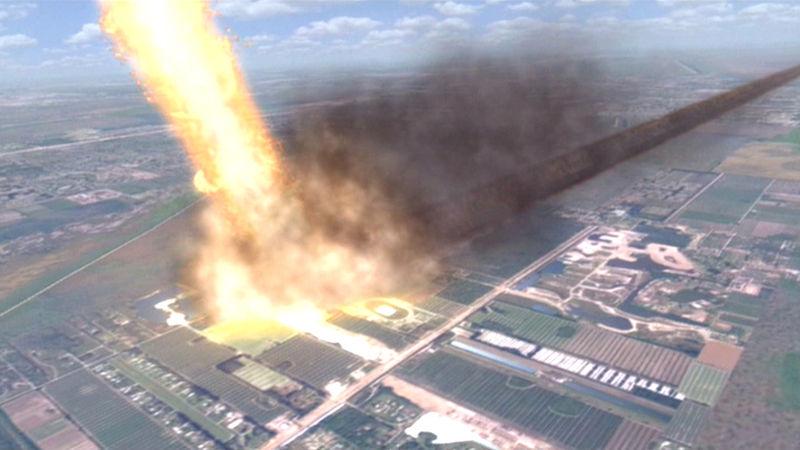| Home | Orbit | Satellite | Power Link | Comm Link | Earth Stations | Cost/Timeline | Employees |
Timeline
Development efforts prior to deployment are estimated to take eight years, with continuing efforts to finish software and other challenges through the beginnings of manufacturing and satellite launch. Satellites are predicted to launch starting after ten years. Nine satellites are to be launched every year for ten years. This will provide the 90 satellites desired.
Estimated spending curves for the first thirty years of the SPS are shown below in billions of dollars. Operational expenses will continue for the lifetime of the satellites.
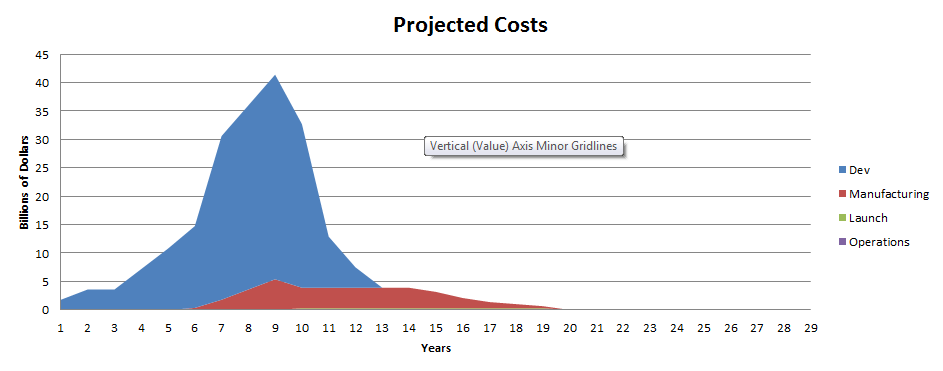
Project Cost
Financial estimates were calculated based on development costs of the ISS. The ISS was chosen because it is the largest most complex system currently in space. Based on total station mass the dollars per kilogram were determined. Using the estimated mass of a single SSP satellite a first unit cost of 5.4 billion dollars was obtained. A twenty percent learning curve with a production of ninety satellites yielded a total cost of forty times the first unit. The LEO assembly costs are considered in the Development & Manufacturing expenses.
Based on the SpaceX Falcon 9 payload delivery capability to LEO of 53,000kg, it was determined that each satellite would require three launches. Based on projected costs of the Falcon 9 Heavy becoming fully reusable with higher launch rates, the cost per kilogram is estimated to be $250/kg for Gen 3. The amount of satellites launches has been growing exponentially for the past decade and this project would add 18 to 45 additional launches per year. $250/kg is a conservative estimate of launch costs provided current trends continue.
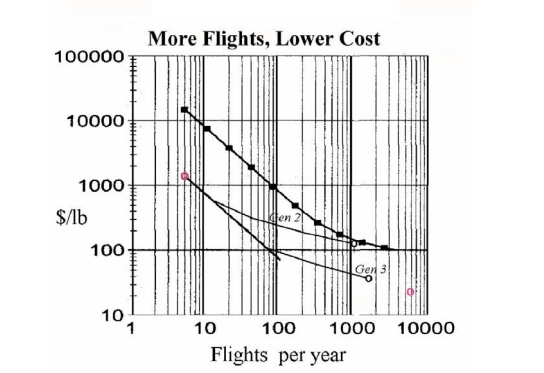
The following table summarizes the non-operational project costs, with an estimated total of 220 billion dollars.
| Development & Manufacturing | Launch Costs | |
| Costs in billions (In 2011 dollars) | 216 | 3 |
Once the earth station is complete and the first satellite begins its orbital transfer from LEO to the HALO orbit the ES must be fully staffed. Based on previous NASA mission personal requirements a minimum of 15 people are required to manage the station keeping and power system links. The following table shows the cost breakdown with a higher than average staff salary (in 2011 dollars).
| Number of Base Stations | 1 |
| People per basestation | 15 |
| Average per person salary | $100,000 |
| Benefits Multiplier | 2 |
| Shifts per day | 3 |
| Total people operational costs / year | $9,000,000 |
Over the thirty year lifetime of the satellites, the operational expenses will total 270 million dollars. Compared to the total system cost, this is negligible.
At the ten year mark satellites will begin being launched into orbit at an increasing rate until 15 satellites per year are being launched. At three flights required per satellite, the number of launches would start at 6 and grow to 45 over 17 years. This will provide a steady growth in the number of power producing satellites until 90 are reached.
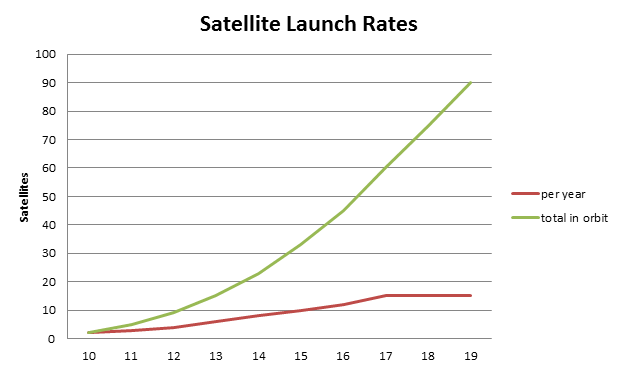
Assuming a 3% loss per year in solar panel efficiency starting at the end of the first year, the constellations power output would grow to almost 5 GW/h over the ten years of launches and then decay to under 3 GW/h over the twenty year lifetime. The constellation would reach roughly 40% efficiency at the end of its life.
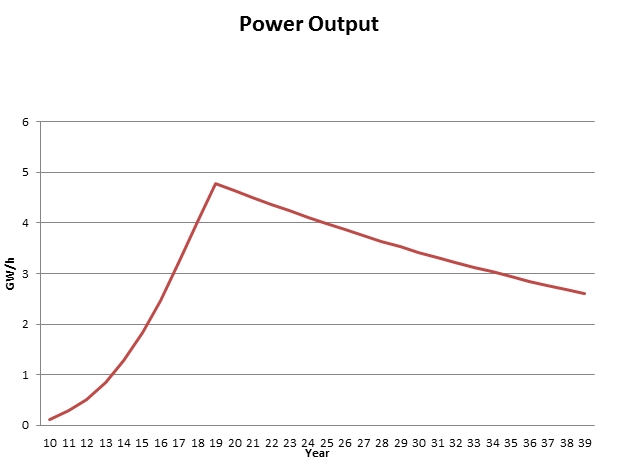
The project cost is assumed to be amortized evenly over the entire 30 years of satellite lifetime. Using a computed value of 787771.18 for the number of produced (added to the power grid) gigawatt hours an energy cost of $0.28/kWh can be calculated.
Current energy costs in Georgia are $0.118/kWh, with energy being traded at an average of $35/MWh. This implies approximately a 4x multiplier when converting between traded energy costs and consumer costs. Energy cost projects for 2030 (in 2011 dollars) are $119/MWh. Assuming the same 4x multiplier gives a project consumer energy cost of $0.48/kWh.
The satellite system represents 58% of projected energy costs.
Additional Cost Saving Methods
Moral issues aside, there would be 90 weaponized laser systems available for time sharing. While there are many issues this could present to the ethical individual, it does provide a substantial means of reducing energy costs further. There are a number of entities, private, corporate, and governmental, that would be willing to pay substantial amounts of money to have a laser capable of very precise pointing and over 580 times more powerful than the most powerful experimental military laser (Northrup has produced a 150kW laser).
Selling this wouldn't be difficult as it could have advertised capabilities to shoot down other satellites, destroy the most heavily armored vehicles, and level small cities.
An EPA study would be necessary to develop safe discharge times for this much energy through the atmosphere. This would be the governing factor of how long each impulse can be and how many discharges per day.
A daily retainer of $750,000 is both reasonable and offsets the satellite earning potential with overage. Based on the future EPA study additional costs will be assessed per shot. Assuming that the environmental impact study would only allow one satellite to be used per day and 50% time sold to militaristic entities over the 30 years, this would generate roughly 4.1 trillion dollars of revenue without the additional per shot charge.
By simply trading moral obligations for monetary use of a super weapon, energy could be free, yet still profitable! Energy crisis averted.
